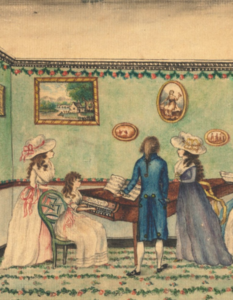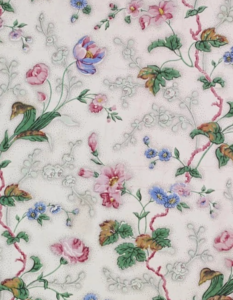“There is a duel to the death between me and my wallpaper. One or the other of us has to go.” Oscar Wilde famously said of his Parisian apartment. No spoilers but- the wallpaper won.
Wilde famously died in the very room referenced…which leaves us to wonder how powerful a home decor trend can actually be.
Wilde wasn’t the only one. Wallpaper has a sordid literary history. Charlotte Perkins Gilman’s feminist masterpiece, The Yellow Wallpaper, it symbolizes, at best, artifice and lack of taste. And at worst? Deception. Madness.
It’s history stretches back to the 2nd century but recently the most maligned pattern– floral wallpaper– is having a day in the sun. Bold tropical prints, hyperrealistic dark Dutch looks, and throwback french garden patterns are gracing the homes of celebrities and top NYC salons, showing us that when it comes to home design:
History repeats itself.
Happy 2,000th Birthday To A Decorative OG.
 Wallpaper is notoriously difficult to trace throughout history.
Wallpaper is notoriously difficult to trace throughout history.
It’s very fragile: easily stained, torned, or burned.
We can trace the origins of floral wallcoverings to prehistoric cave paintings. However, wallpaper as we know it came from China, where Tsai Lun invented paper circa 105 A.D.
The new medium’s decorative potential was an immediate hit with Chinese designers. Emerging artists made a career from hand painting large scale pieces of historical events, landscapes, and– yes flowers!– on paper to cover the walls of prestigious structures.
Then came the European boom of the 15th century.
The emerging middle class drove the trend as wallpaper became an affordable alternative to the tapestries favored by the wealthy. More than art, paper became the finishing layer of a home build- covering up imperfections and adding extra protection from drafty structures.
As soon as it entered merchant class homes, wallpaper took its first hit to its reputation. Even then, wallpaper was looked down as a disdainful cheap and tasteless material that ‘new wealth’ used to ape nobility.
Interesting fact about these early wallpapers: it wasn’t actually secured to the wall. Instead, it was simply hung like the tapestries it was meant to imitate. As demand rose for larger coverings, sections were glued together in the 17th century, transported in the rolled-style we recognize today.
Flocked Damask In The Cocktail Bar
Look at this 2022 flocked damask compared to it’s 1500’s companion:

Two major inventions would drive the initial design trends of wallpaper.
First, the printing press.
With the advent of the printing press, black and white wallpaper with repeating patterns became the new trend. New themes also emerged: political scenes, heraldry, geometric shapes, and patterns meant to mimic rich fabrics like leather and brocade.
In the 16th century, wallpaper would see another major innovation: flocking. This method used a byproduct of cloth-making, flock, to make the paper look like cut velvet. Flocked wallpaper became a way to artificially inflate one’s status.
Flocked wallpaper, with its velvety raised surface, remains the It Girl in wallpaper design today. I can’t tell you how many hair salons, cocktail bars, and nail bars I’ve been at who’ve unknowingly channeled their inner medieval-era designer.
Flowers in Bloom: The 18th Century
 Suddenly, wallpaper was fashionable again. The hallways of Horace Walpole and Thomas Jefferson would secure its rise to the upper crust once more.
Suddenly, wallpaper was fashionable again. The hallways of Horace Walpole and Thomas Jefferson would secure its rise to the upper crust once more.
It only took two hundred years but by 1712, the cheap alternative to tapestries was now important enough for the people in power to take notice. Great Britain introduced a tax on wallpaper and banned its import. The government was serious about the wallpaper trade- forging wallpaper became punishable by death.
As the industry bloomed, it brought with it literal blooms: the popularity of floral wallpaper. In tandem with thought leaders of the day- philosophers like Jean-Jacques Rousseau who insisted humans should cultivate a connection with nature- floral was in.
Technological advancements also allowed for higher quality colored block printing, which rendered repeating lavish, intricate floral patterns in all of their beautiful hues. Vibrant colors were the original hot buy, but they soon gave way to Rococo pastels such as the pastoral French toile (inspired by the fabric of the same name).
France, England, and the British colonies in North America became big markets for new floral wallpaper trends. Wallpaper design became a demarcation of political style: The Netherlands, Switzerland, and Eastern Europe continued to favor Renaissance-inspired styles that imitated heavy fabrics like damask, velvet, and brocade.
But where was the east? The originators’ of wallpaper were about to get their first global economic taste for trade in the product. In the 18th century, Chinese artists began painting non-repeating patterns featuring flowers and birds specifically catered to wealthy Western tastes. Another favorite floral pattern, chintz, is inspired by Indian fabrics.
Chinoiserie and other “exotic” patterns have fallen in and out of fashion from the 1750s through the 1950s as floral wallpaper at the intersection of three of history’s most powerful and controversial -isms: capitalism, consumerism, and imperialism.
How The French Revolution Caused A Wallpaper Fallout

Eastern-produced wallpaper never made it beyond ‘decoration’ in European homes.
The breakthrough from “decor” to true “art” came instead from French artist Jean-Baptiste Réveillon. His floral wallpapers were the premium luxury brand of Europe’s interior design. As official royal wallpaper supplier, he produced elaborate wallpaper panels, framed with gilt edges, for France’s elite.
Réveillon loved natural imagery. Flowers featured prominently in his designs, along with birds, animals, and cornucopias. His wallpaper was seen as so luxuriant that one of the first violent demonstrations of the French Revolution occurred at his factory: The Réveillon riots in 1789.
The French revolution tamped down tastes for excess. With it? Floral wallpaper fell from style. Most early 19th century wallpaper shifted to “plain papers,” a single color that often came with a border or stark geometric patterns, like stripes and lattices. (Think: 1980s wallpaper)
 When the wealthy indulged in floral wallpaper…it wasn’t the same. Panorama or scenic wallpapers depicting nature, history, and mythology instead of using repeated patterns became popular among the wealthy.
When the wealthy indulged in floral wallpaper…it wasn’t the same. Panorama or scenic wallpapers depicting nature, history, and mythology instead of using repeated patterns became popular among the wealthy.
Even with the aftermath of the Réveillon riots, the French continued to drive innovation and design trends. The Zuber factory in Alsace developed a printing technique that allowed for an ombré effect, creating luxurious “rainbow papers” in the 1820s.
But the pre-revolution florals were nowhere to be found.
Floral wallpaper would be out of style for nearly sixty years until a British comeback in 1839.
Maybe We Just Like Our Cheap and Tacky Walls.
 One minute, luxury is the most expensive watch you can buy…and the next minute Cardi B crashes through with an IG Reel that leaves the old money scrambling to redefine their style.
One minute, luxury is the most expensive watch you can buy…and the next minute Cardi B crashes through with an IG Reel that leaves the old money scrambling to redefine their style.
Home design isn’t above the same ebb and flow of trends through class.
Take the British- famously the dressed-in-hand-me-downs youngest child of western Europe when it comes to luxury fashion.
Until the mid-nineteenth century, wallpapers were painstakingly created using a slow, laborious process known as block printing. Even plain designs were expensive…and French. However, in 1839, the English company Potters & Ross cotton firm patented a steam-powered wallpaper printing machine that allowed for mass production of 400 continuous paper rolls per day.
All of the Sudden- Wallpaper Became Accessible.
And the first pattern in the queue? Florals. One of the most popular printed designs involved “cabbages roses”– a large open rose still common in modern floral prints.
 In Great Britain, wallpaper production skyrocketed by 900%. When the wallpaper tax was repealed in 1836 prices fell, making wallpaper accessible once more to the aspiring middle class.
In Great Britain, wallpaper production skyrocketed by 900%. When the wallpaper tax was repealed in 1836 prices fell, making wallpaper accessible once more to the aspiring middle class.
The democratization of wallpaper drew fierce backlash with classist undertones. Art critics like A.W.N. Pugin lambasted naturalistic designs, particularly florals, for being incompatible with a two-dimensional medium like wallpaper.
Pugin called for geometric, symmetrical patterns or a return to the “plain paper” of the early 19th century. Critic Robert Edis considered these forms of wallpaper as more “honest” than the ornate floral designs or panoramic scene.
The arguments against floral design ironically forget wallpaper’s original origins as a cheap way to make a room, and its owner, appear more wealthy to begin with.
The so-called “wallpaper reform movement” relegated floral wallpaper to “cheap” and “tacky” design. But the English kept buying it- and a lot of it- pasting their favorites floor to ceiling as a bit of a middle finger to the design elitists.
Morris Reintroduces Floral

A true Renaissance Man, William Morris is best remembered today for his wallpaper designs, but he was also an author, socialist, and conservation activist.
Morris & Co wallpapers brought together both 18th century and wallpaper reform movement aesthetics. Their floral wallpapers weren’t the literal representation that critics like Pugin abhorred but rather stylized depictions based on the organic forms.
Morris was inspired by ordinary beauty. He loved wildflowers and lifting them to the realm of visual art. This philosophy placed Morris as a pioneer in the larger Arts and Crafts movement sweeping through architecture and design.
 By the late 19th century, wallpaper was so popular that a fad for combining three different patterns in a single application was the style of the day. Walls were divided into three sections: the dado at the bottom (between the chair rail and skirting board), the filling in the middle, and the frieze at the top.The effect was a cluttered visual that calls to mind the Victorian middle class’ passion for collecting kitsch.,
By the late 19th century, wallpaper was so popular that a fad for combining three different patterns in a single application was the style of the day. Walls were divided into three sections: the dado at the bottom (between the chair rail and skirting board), the filling in the middle, and the frieze at the top.The effect was a cluttered visual that calls to mind the Victorian middle class’ passion for collecting kitsch.,
Manufacturers sold wildly popular pattern sets packaged together to give homeowners the perfect look, straight ‘off the shelf’.So popular, in fact, that these dizzying designs were found…everywhere.
Deadly Wallpaper and the Late Victorian Aesthetic
Dado-filling-frieze application became an omnipresent and aggressive style. It’s no surprise that wallpaper, especially in winding floral patterns, cropped up in Victorian literature as a symbol of deceit, doom, and decay in works from Guy de Maupassant’s Bel Ami to Charlotte Perkins Gilman.
And the truth? There was death in the wallpaper.
Morris & Co used a secret ingredient to achieve the lush greens of their floral patterns: arsenic.
Yes, the arsenic and lead content was probably more dangerous for the Morris & Co factory worker than the consumer. Still, a rash of children’s deaths were attributed to the wallcovering. Morris repeatedly claimed his wallpaper had nothing to do with them…but out of caution, he switched to arsenic-free dyes and made a point to advertise the change liberally.
Your Grandmother’s Wallpaper: Floral Wallpaper in the 20th Century
With the dawn of the twentieth century, wallpaper’s popularity began to wane again. The “modern” man desired a style that was fresh- not frenzied- and clean. “Sanitary” papers, designed to be washable, durable, and practical, replaced the complex patterns of the Victorian era.
Wallpaper fell off during World War I. Resource shortages increased production prices and post-war art modernists infinitely preferred painted walls.
But, as with the English wallpaper reform movement 100 years before: critical opinion doesn’t always reflect consumer popularity.
Following WWI, the roaring 1920s had record-breaking wallpaper sales. While florals were still “out”, bold geometric designs inspired by Cubism and the jazz age were “in”. Arabian- and Egyptian-inspired prints also enjoyed their place on the bestsellers in the wake of The Sheik and the discovery of Tutankhamun’s tomb.
Families moving to suburban homes post-World War II would bring back the florals.
Wallpapering a new home was considered a rite of passage and the delicate flowers fit the 1950s Neo-Colonial aesthetic. New plastic resins also made wallpaper more durable and stain-resistant, making it an essential for company-ready rooms.
Flower Power for the Win
 In the 1960s “flower power” took floral wallpaper from stuffy sitting rooms to bold, large prints plastered over kitchens and bathrooms. Burnt orange, mustard yellows, and midcentury browns were printed in sizes that made the early 19th century’s offensively ostentatious cabbage rose pattern look downright tame.
In the 1960s “flower power” took floral wallpaper from stuffy sitting rooms to bold, large prints plastered over kitchens and bathrooms. Burnt orange, mustard yellows, and midcentury browns were printed in sizes that made the early 19th century’s offensively ostentatious cabbage rose pattern look downright tame.
The groovy counterculture design was maximalist in a way reminiscent of the Victorian dado-filling-frieze style: overwhelming amounts of busy floral patterns. The 1990s brought a more subdued palate with the resurgence of English countryside-inspired florals, revised from the 18th century’s chintz and cabbage roses.
Until dot-com tech minimalism and Silicon Valley-style pushed back. Now, every home renovation on HGTV includes a conversation about “cheap and tacky” wallpaper right alongside what will undoubtedly be our own generational design faux pas.
It’s funny how no matter how modern we claim to be, we’re still repeating the pattern (no pun intended!) elitists have been circulating around floral wallpaper since the Middle Ages.
Floral Wallpaper for the Modern Renaissance Woman
 Between COVID-19 and the impending climate crisis, I’ve been making a conscious choice to connect more with the planet.
Between COVID-19 and the impending climate crisis, I’ve been making a conscious choice to connect more with the planet.
2020 made me slow down with daily walks and gave me a chance to observe the subtle changes in the natural world around me. It’s helped me form a necessary informed perspective. Today’s trends in floral wallpapers reflect that same eye toward detail. Modern wallpaper designers are moving away from idealized floral patterns to capturing flowers’ wild beauty in hyper realistic detail.
Which- has always been floral wallpaper’s goal: To bring us closer to the natural world.
Millennials, Gen Z, and beyond have no choice but to live with an earth in peril. When your air quality is too poor from wildfire smoke to walk outside? It makes sense our home design reflects the same longings for natural beauty as the factory-locked family in Industrial Era London.
I can only hope that when the floral trend falls from grace again, it harolds a better turn for the world. Until then, we’ll take our pleasure in floral-festooned selfies and optimistic wall coverings without shame.




